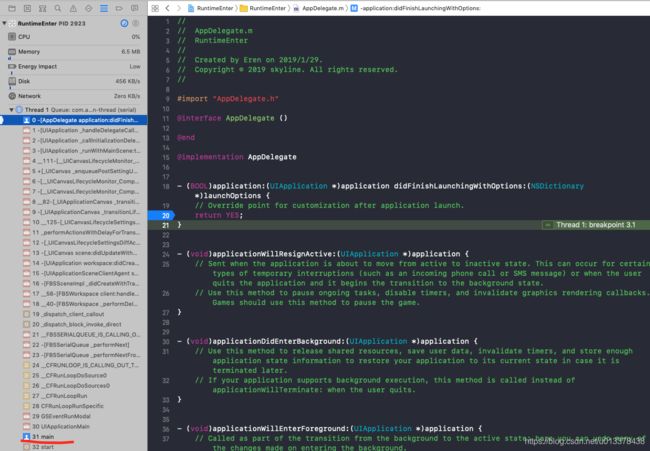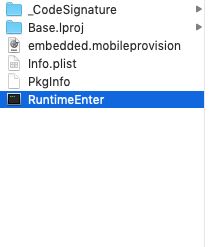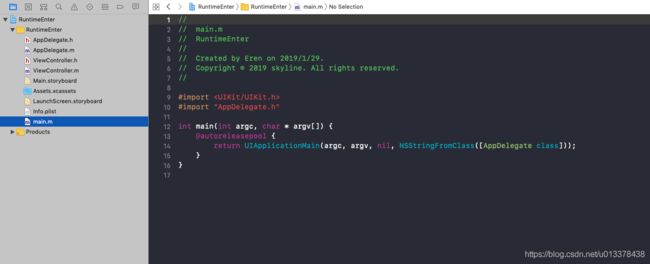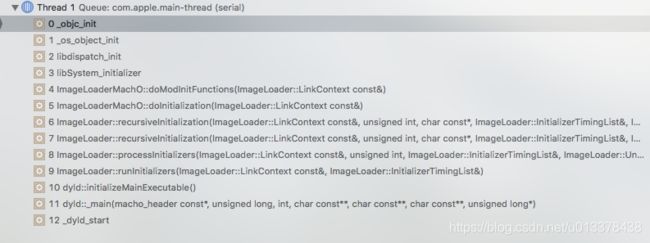Objective-C runtime机制(9)——main函数前发生了什么
在我们的App代码中,XCode会自动创建一个main.m文件,其中定义了main函数
这里的main函数是我们整个App的入口,它的调用时机甚至会早于AppDelegate 中的didFinishLaunching回调。

因此我们会说,main函数是我们App程序的入口点函数。
那么,我们App所运行的第一个函数,真的是main函数吗?如果我们在XCode中设置符号断点void _objc_init(void),则会发现,在进入main函数之前,其实系统还会调用void _objc_init(void) 方法:

这里的_objc_init方法,实际上是runtime的入口函数。
void _objc_init(void)
也就是说,在App的main函数之前,系统会首先对App的runtime运行环境,做了一系列的初始化操作。
而这个runtime入口函数,又是被谁调用起来的呢?答案是苹果的动态链接器dyld(the dynamic link editor)。dyld是一个操作系统级的组件,它会负责iOS系统中每个App启动时的环境初始化以及动态库加载到内存等一系列操作。
在系统内核做好程序准备工作之后,交由dyld负责余下的工作。
在这里再重申一遍,runtime的入口函数是_objc_init,它是在main函数之前被dyld调用的。而+load()方法,则是在main函数前被_objc_init调用。今天,我们就来看一下,在main函数之前,runtime究竟做了哪些初始化工作。
Mach-O格式
在深入了解_objc_init的实现之前,我们需要先了解iOS系统中可执行文件的文件格式:Mach-O格式。关于Mach-O格式,我们在Objective-C runtime机制(前传)——Mach-O格式,Objective-C runtime机制(前传2)——Mach-O格式和runtime中以及介绍过。
我们可以在XCode 工程 product文件夹下找到RuntimeEnter.app工程,用finder打开所在目录,其实RuntimeEnter.app是一个压缩包,用鼠标右键选择show Package Contents ,可以看到下面有这些文件,其中和我们工程同名的可运行程序就是Mach-O格式的可运行文件:

_objc_init
我们在iOS App中设置符号断点_objc_init,则在App启动时(进入main函数之前),会进入如下调用堆栈:
可以看到,其底层是由dyld调用起来的。关于dyld我们不去多说,让我们看一下runtime中_objc_init的定义:
/***********************************************************************
* _objc_init
* Bootstrap initialization. Registers our image notifier with dyld.
* Called by libSystem BEFORE library initialization time
**********************************************************************/
void _objc_init(void)
{
static bool initialized = false;
if (initialized) return;
initialized = true;
// fixme defer initialization until an objc-using image is found?
environ_init();
tls_init();
static_init();
lock_init();
exception_init();
_dyld_objc_notify_register(&map_images, load_images, unmap_image);
}
除去上面一堆init方法,我们重点关注
_dyld_objc_notify_register(&map_images, load_images, unmap_image);
_dyld_objc_notify_register方法注册了对dyld中关于加载images的事件回调:
//
// Note: only for use by objc runtime
// Register handlers to be called when objc images are mapped, unmapped, and initialized.
// Dyld will call back the "mapped" function with an array of images that contain an objc-image-info section.
// Those images that are dylibs will have the ref-counts automatically bumped, so objc will no longer need to
// call dlopen() on them to keep them from being unloaded. During the call to _dyld_objc_notify_register(),
// dyld will call the "mapped" function with already loaded objc images. During any later dlopen() call,
// dyld will also call the "mapped" function. Dyld will call the "init" function when dyld would be called
// initializers in that image. This is when objc calls any +load methods in that image.
//
void _dyld_objc_notify_register(_dyld_objc_notify_mapped mapped,
_dyld_objc_notify_init init,
_dyld_objc_notify_unmapped unmapped);
分别注册了那些事件呢?根据注释,我们可以知道,共注册了三个事件的回调:
- _dyld_objc_notify_mapped : OC image被加载映射到内存(+load()方法在此时被调用)
- _dyld_objc_notify_init : OC image被init时
- _dyld_objc_notify_unmapped : OC image被移除内存时
以上三个回调类型是用的函数指针,定义为
typedef void (*_dyld_objc_notify_mapped)(unsigned count, const char* const paths[], const struct mach_header* const mh[]);
typedef void (*_dyld_objc_notify_init)(const char* path, const struct mach_header* mh);
typedef void (*_dyld_objc_notify_unmapped)(const char* path, const struct mach_header* mh);
_dyld_objc_notify_mapped
当image被dyld加载到内存后,会调用回调_dyld_objc_notify_mapped 。在runtime中,对应的函数是:
void
map_images(unsigned count, const char * const paths[],
const struct mach_header * const mhdrs[])
{
rwlock_writer_t lock(runtimeLock);
return map_images_nolock(count, paths, mhdrs);
}
void
map_images_nolock(unsigned mhCount, const char * const mhPaths[],
const struct mach_header * const mhdrs[])
{
static bool firstTime = YES;
header_info *hList[mhCount];
uint32_t hCount;
size_t selrefCount = 0;
// Perform first-time initialization if necessary.
// This function is called before ordinary library initializers.
// fixme defer initialization until an objc-using image is found?
if (firstTime) {
preopt_init();
}
if (PrintImages) {
_objc_inform("IMAGES: processing %u newly-mapped images...\n", mhCount);
}
// Find all images with Objective-C metadata.
hCount = 0;
// Count classes. Size various table based on the total.
int totalClasses = 0;
int unoptimizedTotalClasses = 0;
{
uint32_t i = mhCount;
while (i--) {
const headerType *mhdr = (const headerType *)mhdrs[i];
auto hi = addHeader(mhdr, mhPaths[i], totalClasses, unoptimizedTotalClasses);
if (!hi) {
// no objc data in this entry
continue;
}
if (mhdr->filetype == MH_EXECUTE) {
// Size some data structures based on main executable's size
#if __OBJC2__
size_t count;
_getObjc2SelectorRefs(hi, &count);
selrefCount += count;
_getObjc2MessageRefs(hi, &count);
selrefCount += count;
#else
_getObjcSelectorRefs(hi, &selrefCount);
#endif
#if SUPPORT_GC_COMPAT
// Halt if this is a GC app.
if (shouldRejectGCApp(hi)) {
_objc_fatal_with_reason
(OBJC_EXIT_REASON_GC_NOT_SUPPORTED,
OS_REASON_FLAG_CONSISTENT_FAILURE,
"Objective-C garbage collection "
"is no longer supported.");
}
#endif
}
hList[hCount++] = hi;
if (PrintImages) {
_objc_inform("IMAGES: loading image for %s%s%s%s%s\n",
hi->fname(),
mhdr->filetype == MH_BUNDLE ? " (bundle)" : "",
hi->info()->isReplacement() ? " (replacement)" : "",
hi->info()->hasCategoryClassProperties() ? " (has class properties)" : "",
hi->info()->optimizedByDyld()?" (preoptimized)":"");
}
}
}
// Perform one-time runtime initialization that must be deferred until
// the executable itself is found. This needs to be done before
// further initialization.
// (The executable may not be present in this infoList if the
// executable does not contain Objective-C code but Objective-C
// is dynamically loaded later.
if (firstTime) {
sel_init(selrefCount);
arr_init();
#if SUPPORT_GC_COMPAT
// Reject any GC images linked to the main executable.
// We already rejected the app itself above.
// Images loaded after launch will be rejected by dyld.
for (uint32_t i = 0; i < hCount; i++) {
auto hi = hList[i];
auto mh = hi->mhdr();
if (mh->filetype != MH_EXECUTE && shouldRejectGCImage(mh)) {
_objc_fatal_with_reason
(OBJC_EXIT_REASON_GC_NOT_SUPPORTED,
OS_REASON_FLAG_CONSISTENT_FAILURE,
"%s requires Objective-C garbage collection "
"which is no longer supported.", hi->fname());
}
}
#endif
#if TARGET_OS_OSX
// Disable +initialize fork safety if the app is too old (< 10.13).
// Disable +initialize fork safety if the app has a
// __DATA,__objc_fork_ok section.
if (dyld_get_program_sdk_version() < DYLD_MACOSX_VERSION_10_13) {
DisableInitializeForkSafety = true;
if (PrintInitializing) {
_objc_inform("INITIALIZE: disabling +initialize fork "
"safety enforcement because the app is "
"too old (SDK version " SDK_FORMAT ")",
FORMAT_SDK(dyld_get_program_sdk_version()));
}
}
for (uint32_t i = 0; i < hCount; i++) {
auto hi = hList[i];
auto mh = hi->mhdr();
if (mh->filetype != MH_EXECUTE) continue;
unsigned long size;
if (getsectiondata(hi->mhdr(), "__DATA", "__objc_fork_ok", &size)) {
DisableInitializeForkSafety = true;
if (PrintInitializing) {
_objc_inform("INITIALIZE: disabling +initialize fork "
"safety enforcement because the app has "
"a __DATA,__objc_fork_ok section");
}
}
break; // assume only one MH_EXECUTE image
}
#endif
}
if (hCount > 0) {
_read_images(hList, hCount, totalClasses, unoptimizedTotalClasses);
}
firstTime = NO;
}
map_images方法实质上会调用map_images_nolock方法。
而在map_images_nolock内部,又调用了_read_images方法,其核心是用来读取Mach-O格式文件的runtime相关的section信息,并转化为runtime内部的数据结构。
我们来看一下_read_images 方法的实现:
void _read_images(header_info **hList, uint32_t hCount, int totalClasses, int unoptimizedTotalClasses)
{
header_info *hi;
uint32_t hIndex;
size_t count;
size_t i;
Class *resolvedFutureClasses = nil;
size_t resolvedFutureClassCount = 0;
static bool doneOnce;
TimeLogger ts(PrintImageTimes);
runtimeLock.assertWriting();
#define EACH_HEADER \
hIndex = 0; \
hIndex < hCount && (hi = hList[hIndex]); \
hIndex++
if (!doneOnce) {
doneOnce = YES;
#if SUPPORT_NONPOINTER_ISA
// Disable non-pointer isa under some conditions.
# if SUPPORT_INDEXED_ISA
// Disable nonpointer isa if any image contains old Swift code
for (EACH_HEADER) {
if (hi->info()->containsSwift() &&
hi->info()->swiftVersion() < objc_image_info::SwiftVersion3)
{
DisableNonpointerIsa = true;
if (PrintRawIsa) {
_objc_inform("RAW ISA: disabling non-pointer isa because "
"the app or a framework contains Swift code "
"older than Swift 3.0");
}
break;
}
}
# endif
# if TARGET_OS_OSX
// Disable non-pointer isa if the app is too old
// (linked before OS X 10.11)
if (dyld_get_program_sdk_version() < DYLD_MACOSX_VERSION_10_11) {
DisableNonpointerIsa = true;
if (PrintRawIsa) {
_objc_inform("RAW ISA: disabling non-pointer isa because "
"the app is too old (SDK version " SDK_FORMAT ")",
FORMAT_SDK(dyld_get_program_sdk_version()));
}
}
// Disable non-pointer isa if the app has a __DATA,__objc_rawisa section
// New apps that load old extensions may need this.
for (EACH_HEADER) {
if (hi->mhdr()->filetype != MH_EXECUTE) continue;
unsigned long size;
if (getsectiondata(hi->mhdr(), "__DATA", "__objc_rawisa", &size)) {
DisableNonpointerIsa = true;
if (PrintRawIsa) {
_objc_inform("RAW ISA: disabling non-pointer isa because "
"the app has a __DATA,__objc_rawisa section");
}
}
break; // assume only one MH_EXECUTE image
}
# endif
#endif
if (DisableTaggedPointers) {
disableTaggedPointers();
}
if (PrintConnecting) {
_objc_inform("CLASS: found %d classes during launch", totalClasses);
}
// namedClasses
// Preoptimized classes don't go in this table.
// 4/3 is NXMapTable's load factor
int namedClassesSize =
(isPreoptimized() ? unoptimizedTotalClasses : totalClasses) * 4 / 3;
gdb_objc_realized_classes =
NXCreateMapTable(NXStrValueMapPrototype, namedClassesSize);
ts.log("IMAGE TIMES: first time tasks");
}
// Discover classes. Fix up unresolved future classes. Mark bundle classes.
for (EACH_HEADER) {
if (! mustReadClasses(hi)) {
// Image is sufficiently optimized that we need not call readClass()
continue;
}
bool headerIsBundle = hi->isBundle();
bool headerIsPreoptimized = hi->isPreoptimized();
classref_t *classlist = _getObjc2ClassList(hi, &count);
for (i = 0; i < count; i++) {
Class cls = (Class)classlist[i];
Class newCls = readClass(cls, headerIsBundle, headerIsPreoptimized);
if (newCls != cls && newCls) {
// Class was moved but not deleted. Currently this occurs
// only when the new class resolved a future class.
// Non-lazily realize the class below.
resolvedFutureClasses = (Class *)
realloc(resolvedFutureClasses,
(resolvedFutureClassCount+1) * sizeof(Class));
resolvedFutureClasses[resolvedFutureClassCount++] = newCls;
}
}
}
ts.log("IMAGE TIMES: discover classes");
// Fix up remapped classes
// Class list and nonlazy class list remain unremapped.
// Class refs and super refs are remapped for message dispatching.
if (!noClassesRemapped()) {
for (EACH_HEADER) {
Class *classrefs = _getObjc2ClassRefs(hi, &count);
for (i = 0; i < count; i++) {
remapClassRef(&classrefs[i]);
}
// fixme why doesn't test future1 catch the absence of this?
classrefs = _getObjc2SuperRefs(hi, &count);
for (i = 0; i < count; i++) {
remapClassRef(&classrefs[i]);
}
}
}
ts.log("IMAGE TIMES: remap classes");
// Fix up @selector references
static size_t UnfixedSelectors;
sel_lock();
for (EACH_HEADER) {
if (hi->isPreoptimized()) continue;
bool isBundle = hi->isBundle();
SEL *sels = _getObjc2SelectorRefs(hi, &count);
UnfixedSelectors += count;
for (i = 0; i < count; i++) {
const char *name = sel_cname(sels[i]);
sels[i] = sel_registerNameNoLock(name, isBundle);
}
}
sel_unlock();
ts.log("IMAGE TIMES: fix up selector references");
#if SUPPORT_FIXUP
// Fix up old objc_msgSend_fixup call sites
for (EACH_HEADER) {
message_ref_t *refs = _getObjc2MessageRefs(hi, &count);
if (count == 0) continue;
if (PrintVtables) {
_objc_inform("VTABLES: repairing %zu unsupported vtable dispatch "
"call sites in %s", count, hi->fname());
}
for (i = 0; i < count; i++) {
fixupMessageRef(refs+i);
}
}
ts.log("IMAGE TIMES: fix up objc_msgSend_fixup");
#endif
// Discover protocols. Fix up protocol refs.
for (EACH_HEADER) {
extern objc_class OBJC_CLASS_$_Protocol;
Class cls = (Class)&OBJC_CLASS_$_Protocol;
assert(cls);
NXMapTable *protocol_map = protocols();
bool isPreoptimized = hi->isPreoptimized();
bool isBundle = hi->isBundle();
protocol_t **protolist = _getObjc2ProtocolList(hi, &count);
for (i = 0; i < count; i++) {
readProtocol(protolist[i], cls, protocol_map,
isPreoptimized, isBundle);
}
}
ts.log("IMAGE TIMES: discover protocols");
// Fix up @protocol references
// Preoptimized images may have the right
// answer already but we don't know for sure.
for (EACH_HEADER) {
protocol_t **protolist = _getObjc2ProtocolRefs(hi, &count);
for (i = 0; i < count; i++) {
remapProtocolRef(&protolist[i]);
}
}
ts.log("IMAGE TIMES: fix up @protocol references");
// Realize non-lazy classes (for +load methods and static instances)
for (EACH_HEADER) {
classref_t *classlist =
_getObjc2NonlazyClassList(hi, &count);
for (i = 0; i < count; i++) {
Class cls = remapClass(classlist[i]);
if (!cls) continue;
// hack for class __ARCLite__, which didn't get this above
#if TARGET_OS_SIMULATOR
if (cls->cache._buckets == (void*)&_objc_empty_cache &&
(cls->cache._mask || cls->cache._occupied))
{
cls->cache._mask = 0;
cls->cache._occupied = 0;
}
if (cls->ISA()->cache._buckets == (void*)&_objc_empty_cache &&
(cls->ISA()->cache._mask || cls->ISA()->cache._occupied))
{
cls->ISA()->cache._mask = 0;
cls->ISA()->cache._occupied = 0;
}
#endif
realizeClass(cls);
}
}
ts.log("IMAGE TIMES: realize non-lazy classes");
// Realize newly-resolved future classes, in case CF manipulates them
if (resolvedFutureClasses) {
for (i = 0; i < resolvedFutureClassCount; i++) {
realizeClass(resolvedFutureClasses[i]);
resolvedFutureClasses[i]->setInstancesRequireRawIsa(false/*inherited*/);
}
free(resolvedFutureClasses);
}
ts.log("IMAGE TIMES: realize future classes");
// Discover categories.
for (EACH_HEADER) {
category_t **catlist =
_getObjc2CategoryList(hi, &count);
bool hasClassProperties = hi->info()->hasCategoryClassProperties();
for (i = 0; i < count; i++) {
category_t *cat = catlist[i];
Class cls = remapClass(cat->cls);
if (!cls) {
// Category's target class is missing (probably weak-linked).
// Disavow any knowledge of this category.
catlist[i] = nil;
if (PrintConnecting) {
_objc_inform("CLASS: IGNORING category \?\?\?(%s) %p with "
"missing weak-linked target class",
cat->name, cat);
}
continue;
}
// Process this category.
// First, register the category with its target class.
// Then, rebuild the class's method lists (etc) if
// the class is realized.
bool classExists = NO;
if (cat->instanceMethods || cat->protocols
|| cat->instanceProperties)
{
addUnattachedCategoryForClass(cat, cls, hi);
if (cls->isRealized()) {
remethodizeClass(cls);
classExists = YES;
}
if (PrintConnecting) {
_objc_inform("CLASS: found category -%s(%s) %s",
cls->nameForLogging(), cat->name,
classExists ? "on existing class" : "");
}
}
if (cat->classMethods || cat->protocols
|| (hasClassProperties && cat->_classProperties))
{
addUnattachedCategoryForClass(cat, cls->ISA(), hi);
if (cls->ISA()->isRealized()) {
remethodizeClass(cls->ISA());
}
if (PrintConnecting) {
_objc_inform("CLASS: found category +%s(%s)",
cls->nameForLogging(), cat->name);
}
}
}
}
ts.log("IMAGE TIMES: discover categories");
// Category discovery MUST BE LAST to avoid potential races
// when other threads call the new category code before
// this thread finishes its fixups.
// +load handled by prepare_load_methods()
if (DebugNonFragileIvars) {
realizeAllClasses();
}
// Print preoptimization statistics
if (PrintPreopt) {
static unsigned int PreoptTotalMethodLists;
static unsigned int PreoptOptimizedMethodLists;
static unsigned int PreoptTotalClasses;
static unsigned int PreoptOptimizedClasses;
for (EACH_HEADER) {
if (hi->isPreoptimized()) {
_objc_inform("PREOPTIMIZATION: honoring preoptimized selectors "
"in %s", hi->fname());
}
else if (hi->info()->optimizedByDyld()) {
_objc_inform("PREOPTIMIZATION: IGNORING preoptimized selectors "
"in %s", hi->fname());
}
classref_t *classlist = _getObjc2ClassList(hi, &count);
for (i = 0; i < count; i++) {
Class cls = remapClass(classlist[i]);
if (!cls) continue;
PreoptTotalClasses++;
if (hi->isPreoptimized()) {
PreoptOptimizedClasses++;
}
const method_list_t *mlist;
if ((mlist = ((class_ro_t *)cls->data())->baseMethods())) {
PreoptTotalMethodLists++;
if (mlist->isFixedUp()) {
PreoptOptimizedMethodLists++;
}
}
if ((mlist=((class_ro_t *)cls->ISA()->data())->baseMethods())) {
PreoptTotalMethodLists++;
if (mlist->isFixedUp()) {
PreoptOptimizedMethodLists++;
}
}
}
}
_objc_inform("PREOPTIMIZATION: %zu selector references not "
"pre-optimized", UnfixedSelectors);
_objc_inform("PREOPTIMIZATION: %u/%u (%.3g%%) method lists pre-sorted",
PreoptOptimizedMethodLists, PreoptTotalMethodLists,
PreoptTotalMethodLists
? 100.0*PreoptOptimizedMethodLists/PreoptTotalMethodLists
: 0.0);
_objc_inform("PREOPTIMIZATION: %u/%u (%.3g%%) classes pre-registered",
PreoptOptimizedClasses, PreoptTotalClasses,
PreoptTotalClasses
? 100.0*PreoptOptimizedClasses/PreoptTotalClasses
: 0.0);
_objc_inform("PREOPTIMIZATION: %zu protocol references not "
"pre-optimized", UnfixedProtocolReferences);
}
#undef EACH_HEADER
}
_read_images 方法写了很长,其实就是做了一件事,将Mach-O文件的section依次读取,并根据内容初始化runtime的内存结构。
根据注释,_read_images 方法主要做了下面这些事情:
- 是否需要禁用isa优化。这里有三种情况:使用了swift 3.0前的swift代码。OSX版本早于10.11。在OSX系统下,Mach-O的DATA段明确指明了__objc_rawisa(不使用优化的isa)。
- 在
__objc_classlistsection中读取class list - 在
__objc_classrefssection中读取class 引用的信息,并调用remapClassRef方法来处理。 - 在
__objc_selrefssection中读取selector的引用信息,并调用sel_registerNameNoLock方法处理。 - 在
__objc_protolistsection中读取cls的Protocol信息,并调用readProtocol方法来读取Protocol信息。 - 在
__objc_protorefssection中读取protocol的ref信息,并调用remapProtocolRef方法来处理。 - 在
__objc_nlclslistsection中读取non-lazy class信息,并调用static Class realizeClass(Class cls)方法来实现这些class。realizeClass方法核心是初始化objc_class数据结构,赋予初始值。 - 在
__objc_catlistsection中读取category信息,并调用addUnattachedCategoryForClass方法来为类或元类添加对应的方法,属性和协议。关于Category,我们在前面的文章中,已经有过相关的讨论。
OK,以上就是在dyld将image map到内存后,runtime所做的事情:**根据Mach-O相关section中的信息,来初始化runtim的内存结构。**
_dyld_objc_notify_init
当dyld要init image的时候,会产生_dyld_objc_notify_init通知。在runime中, 是通过load_images方法做回调响应的。
void
load_images(const char *path __unused, const struct mach_header *mh)
{
// Return without taking locks if there are no +load methods here.
if (!hasLoadMethods((const headerType *)mh)) return;
recursive_mutex_locker_t lock(loadMethodLock);
// Discover load methods
{
rwlock_writer_t lock2(runtimeLock);
prepare_load_methods((const headerType *)mh);
}
// Call +load methods (without runtimeLock - re-entrant)
call_load_methods();
}
在load_images方法其实就是干了一件事,调用Class的+load()方法。
runtime调用+load()方法分为两步走:
- Discover load methods
- Call +load methods
Discover load methods
在Discover load methods中,会调用prepare_load_methods 来处理+load 方法:
void prepare_load_methods(const headerType *mhdr)
{
size_t count, i;
runtimeLock.assertWriting();
// 添加 class 到 call +load 队列(super class 会在 subclass之前)
classref_t *classlist =
_getObjc2NonlazyClassList(mhdr, &count);
for (i = 0; i < count; i++) {
schedule_class_load(remapClass(classlist[i]));
}
// 添加 category到call +load 队列
category_t **categorylist = _getObjc2NonlazyCategoryList(mhdr, &count);
for (i = 0; i < count; i++) {
category_t *cat = categorylist[i];
Class cls = remapClass(cat->cls);
if (!cls) continue; // category for ignored weak-linked class
realizeClass(cls);
assert(cls->ISA()->isRealized());
add_category_to_loadable_list(cat);
}
}
prepare_load_methods 逻辑分为两个部分:
- 调用
schedule_class_load来组织class的+load方法 - 调用
add_category_to_loadable_list来组织category的+load方法
schedule_class_load 方法实现如下:
static void schedule_class_load(Class cls)
{
if (!cls) return;
assert(cls->isRealized()); // _read_images should realize
if (cls->data()->flags & RW_LOADED) return;
// Ensure superclass-first ordering
schedule_class_load(cls->superclass);
add_class_to_loadable_list(cls);
cls->setInfo(RW_LOADED);
}
这是一个递归调用,会先把superclass用add_class_to_loadable_list方法到loadable class list中:
void add_class_to_loadable_list(Class cls)
{
IMP method;
loadMethodLock.assertLocked();
method = cls->getLoadMethod();
if (!method) return; // Don't bother if cls has no +load method
if (PrintLoading) {
_objc_inform("LOAD: class '%s' scheduled for +load",
cls->nameForLogging());
}
if (loadable_classes_used == loadable_classes_allocated) {
loadable_classes_allocated = loadable_classes_allocated*2 + 16;
loadable_classes = (struct loadable_class *)
realloc(loadable_classes,
loadable_classes_allocated *
sizeof(struct loadable_class));
}
loadable_classes[loadable_classes_used].cls = cls;
loadable_classes[loadable_classes_used].method = method;
loadable_classes_used++;
}
static struct loadable_class *loadable_classes = nil;
从上面的方法可以看出,每一个定义了+load的类,都会被放到loadable_classes中。
因此,+load方法并不存在子类重写父类之说。而且父类的+load方法会先于子类调用。
在来看一下add_category_to_loadable_list方法:
void add_category_to_loadable_list(Category cat)
{
IMP method;
loadMethodLock.assertLocked();
method = _category_getLoadMethod(cat);
// Don't bother if cat has no +load method
if (!method) return;
if (PrintLoading) {
_objc_inform("LOAD: category '%s(%s)' scheduled for +load",
_category_getClassName(cat), _category_getName(cat));
}
if (loadable_categories_used == loadable_categories_allocated) {
loadable_categories_allocated = loadable_categories_allocated*2 + 16;
loadable_categories = (struct loadable_category *)
realloc(loadable_categories,
loadable_categories_allocated *
sizeof(struct loadable_category));
}
loadable_categories[loadable_categories_used].cat = cat;
loadable_categories[loadable_categories_used].method = method;
loadable_categories_used++;
}
static struct loadable_category *loadable_categories = nil;
在add_category_to_loadable_list 方法中,会将所有定义了+load方法的category都放到loadable_categories队列中。
Call +load methods
将定义了+load方法的class和category分别放到loadable_classes 和 loadable_categories 队列后,runtime就会依次读取队列中的class和category,并为之调用+load方法:
void call_load_methods(void)
{
static bool loading = NO;
bool more_categories;
loadMethodLock.assertLocked();
// Re-entrant calls do nothing; the outermost call will finish the job.
if (loading) return;
loading = YES;
void *pool = objc_autoreleasePoolPush();
do {
// 1. Repeatedly call class +loads until there aren't any more
while (loadable_classes_used > 0) {
call_class_loads();
}
// 2. Call category +loads ONCE
more_categories = call_category_loads();
// 3. Run more +loads if there are classes OR more untried categories
} while (loadable_classes_used > 0 || more_categories);
objc_autoreleasePoolPop(pool);
loading = NO;
}
从上面的call_load_methods方法可以看出:
- super class的+load方法调用时机是先于sub class的
- class的+load方法调用时机是先于category的
_dyld_objc_notify_unmapped
当dyld要将image移除内存时,会发送_dyld_objc_notify_unmapped通知。在runtime中,是用unmap_image方法来响应的。
void
unmap_image(const char *path __unused, const struct mach_header *mh)
{
recursive_mutex_locker_t lock(loadMethodLock);
rwlock_writer_t lock2(runtimeLock);
unmap_image_nolock(mh);
}
void
unmap_image_nolock(const struct mach_header *mh)
{
if (PrintImages) {
_objc_inform("IMAGES: processing 1 newly-unmapped image...\n");
}
header_info *hi;
// Find the runtime's header_info struct for the image
for (hi = FirstHeader; hi != NULL; hi = hi->getNext()) {
if (hi->mhdr() == (const headerType *)mh) {
break;
}
}
if (!hi) return;
if (PrintImages) {
_objc_inform("IMAGES: unloading image for %s%s%s\n",
hi->fname(),
hi->mhdr()->filetype == MH_BUNDLE ? " (bundle)" : "",
hi->info()->isReplacement() ? " (replacement)" : "");
}
_unload_image(hi);
// Remove header_info from header list
removeHeader(hi);
free(hi);
}
主要是做了header信息的移除。
总结
在本篇文章中,我们知道了dyld在main()函数之前,会调用runtime的_objc_init 方法。_objc_init是runtime的入口函数,它会根据Mach-O文件中相关的section信息来初始化runtime内存空间。比如,加载class,protocol,以及附加category到class,调用+load方法等。
当然,在main()函数前,dyld除了调用_objc_init 外,还会做许多其他的操作。如将动态链接库加载入内存。但这就不属于runtime的范畴了,我们不去深究。
当dyld将我们App的运行环境都准备好后,dyld 会清理现场,将调用栈回归,调用main()函数,这时候,我们的App就算启动了:

int main(int argc, char * argv[]) {
@autoreleasepool {
return UIApplicationMain(argc, argv, nil, NSStringFromClass([AppDelegate class]));
}
}
在main()函数被调用前,系统其实已经为我们做了很多的准备工作。就像sunnyxx在其博客中说的:
孤独的 main 函数,看上去是程序的开始,却是一段精彩的终结
参考资料
dyld详解
iOS 程序 main 函数之前发生了什么

